|
|

by Zecharia Sitchin
from
Sitchin
Website
|
Contents
Additional Information
The Case
Of The Missing Elephant
2000
The ruins and remains of Mexico's pre-Columbian civilizations
enchant, intrigue, fascinate and puzzle. Of them the oldest and
earliest, that of people referred-to as Olmecs, is the most
enigmatic -- for they challenge present-day scholars to explain how
had people from Africa come and settled and thrived in this part of
the New World, thousands of years before Columbus.
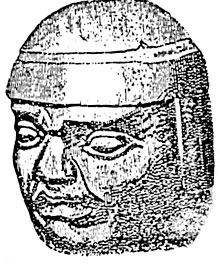 The
Discovery The
Discovery
We know how they looked because they left behind countless
sculptures, marvelously carved in stone, depicting them; some, in
fact, are stone portraits of Olmec leaders; colossal in size, they
immortalize in stone what, to many, has been an unpleasant enigma.
The first colossal stone head was discovered in the Mexican state of
Veracruz back in 1869. Its discoverer reported it in the Bulletin of
the Mexican Geographical and Statistical Society as "a magnificent
sculpture that most amazingly represents an Ethiopian." The report
included a drawing clearly showing the stone head's Negroid
features; and that doomed the discovery to oblivion...
The
Re-Discovery
It was not until 1925 that the existence of the Olmecs was
reaffirmed when an
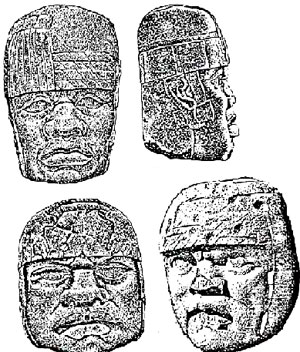 archaeological
team from Tulane University found another such gigantic stone head
in the adjoining Mexican state of Tabasco; it measured about eight
feet in height and weighed some twenty four tons. archaeological
team from Tulane University found another such gigantic stone head
in the adjoining Mexican state of Tabasco; it measured about eight
feet in height and weighed some twenty four tons.
In time, many more such colossal sculptures have been found; they
depict distinctly different individuals wearing helmets; they also
clearly depict, in each case, a person with African features --
black Africans.
As archaeological discovery followed archaeological discovery, it
became evident that in a vast central area of Mexico stretching from
the Gulf coast to the Pacific coast, these "Olmecs" built major
urban centers, engaged in mining, were the first in Mesoamerica to
have a calendar and hieroglyphic writing, and established what is by
now recognized as Mesoamerica's Mother Civilization.
The Unpleasant
Problem
The problem that this posed was twofold: Not only the issue of
Negroid Africans somehow crossing the Atlantic Ocean and settling in
the New World before others; but also the incredible antiquity of
such arrival. This problem was dealt with by first suggesting that
the Olmecs appeared after more famed peoples such as the Mayas; then
by grudgingly acknowledging earlier dates B.C. --250 B.C., then 500
B.C., then 1250 B.C., then even 1500 B.C.
Faced with such evidence, the solution was to deny that these were
Africans ... Even now a noted scholar, writing in the official
catalogue of the Museum of Anthropology of Jalapa, states in regard
to the individuals depicted in the sculptures:
"in spite of the
general similarity of features -- flat noses with flaring nostrils
and thickened lips (leading some to falsely claim an African origin
for the Olmec)," etc.
So: "To falsely claim an African origin for the Olmecs"!
And this brings me to the Case of the Missing Elephant.
An Elephant
Among the Wheels
Jalapa, a gem of a town, is about two hours' drive from Veracruz
(where the Spanish Conquistador Hernan Cortes landed in 1519). Its
museum is undoubtedly second only to the famed one in Mexico City;
but unlike Mexico City's which displays artifacts from all over the
country, the Jalapa one exhibits only locally discovered artifacts
-- predominantly Olmec ones.
Dramatically and effectively displayed in an innovative setting, the
Museum boasts several colossal stone heads as well as other stone
sculptures. It also displays smaller objects found at Olmec sites;
among them, in special display showcases,
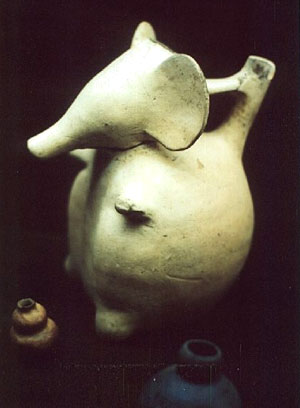 are
what are considered to be Olmec "toys." They include animals mounted
on wheels -- a visual and evidentiary negation of the common claim
that the people of Mesoamerica (and America in general) were
unfamiliar with the wheel. are
what are considered to be Olmec "toys." They include animals mounted
on wheels -- a visual and evidentiary negation of the common claim
that the people of Mesoamerica (and America in general) were
unfamiliar with the wheel.
And included in the same display case were elephants -- "toys" made
of clay.
Gone - Where and Why?
I, and some of my fans who accompanied me, saw them on previous
visits to the Museum.
BUT when I (and again some of my fans with me) was there recently --
in December 1999 -- the elephants were nowhere in sight!
I could find no one in authority to obtain an explanation from. But
that the elephants were once there was a fact indeed, here is a
photograph of one, shot on a previous visit:
Now, here is the significance of this small artifact: There are no,
and never have been, elephants in the Americas. There are and have
been elephants in Africa. And a depiction of an elephant could have
been made only by someone who has seen an elephant, i.e. someone who
has been to Africa!
At this and other museums later visited in December 1999, guards
have asserted that objects that I wished to point out and that were
written up in my book
The Lost Realms but somehow vanished, were
loaned for an overseas exhibit.
Perhaps. But that such a hard-to-explain depiction of an elephant
would be selected to highlight Mexico's ancient heritage, is either
unlikely or highly significant.
I suppose one will have to revisit Jalapa and find out whether the
little elephant is back among the "toys."
Back to Contents
The Olmec
Enigma
Astronaut Corroborates Sitchin
November 2000
If an astronaut were ever to corroborate
an aspect of my writings, I would have expected it to be in regard
to planetary matters. Surprisingly, such a corroboration concerns,
of all things, the Olmecs of ancient Mexico.
The unexpected corroboration is tucked away in the recently
published book A Leap of Faith by the Mercury-7 astronaut
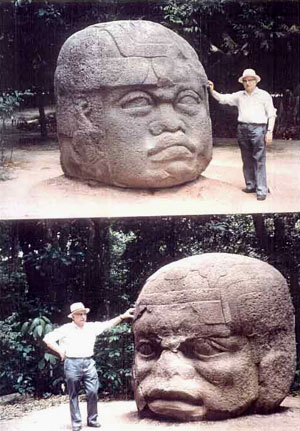 Gordon
Cooper, in which his story as a test pilot and astronaut is peppered
with (to quote from the dust jacket), Gordon
Cooper, in which his story as a test pilot and astronaut is peppered
with (to quote from the dust jacket),
"his strong views on the
existence of extraterrestrial intelligence -- and even the distinct
possibility that we have already had contact."
The Olmec
Enigma
Readers of my books, and especially of
The Lost Realms, as well as
of a previous article on this website titled "The Case of the
Missing Elephant," know by now that beginning with the discovery of
a colossal stone head in 1869, an advanced civilization that
preceded the Mayas and Aztecs of Mexico came to light. Its leaders
and bearers were unmistakably black Africans.
They were arbitrarily
named by archaeologists "Olmecs"; and their embarrassing enigma --
of who they were, and how they had come across the ocean, and why,
was compounded by the timing of their arrival in the New World.
Once it was conceded (very grudgingly!) that the 'Olmecs' did indeed
represent the earliest or even Mother Civilization of Mesoamerica,
the date of their arrival was at first set at about 250 B.C.; then
at about 500 B.C.; then farther back and back, until 1500 B.C. was
acknowledged.
But I have argued for a date twice as old!
A God and His
Secret Number
My conclusion that the Olmec presence in the New World went back at
least 5,000 years, to circa 3000 B.C., was reached by many paths.
The first one was an attempt to identify the great god of
Mesoamerica, the Winged Serpent (Quetzalcoatl to the Aztecs,
Kukulkan to the Mayas), and the significance of his promise to
return to those lands on the first day of a 52-year cycle, (AD 1519,
when the Aztec king Montezuma believed that the appearance of the
Spanish conquistador Cortez was such a Return, coincided with the
anticipated sacred date).
The peoples of Mesoamerica employed in addition to a practical
calendar of 365 days, called the Haab, also a Sacred Calendar
(called
Tzolkin) of 260 days. The two cyclical calendars were
conceived as two wheels with meshing teeth that turned and returned
to the same spot once in 52 years; and 52 was the Sacred Number of
the Winged Serpent god?
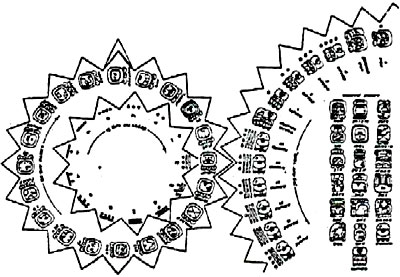
Since 52 was also the Secret Number of
the god known to the Egyptians as Thoth; since Thoth as
Quetzalcoatl, was the god of science and the calendar; and since Thoth was exiled from Egypt circa 3100 B.C., I have suggested that
it was he who took a group of his African followers to a new land,
bringing the "Olmecs" to Mesoamerica.
Accordingly, I said, Olmec presence goes back to at least 3000 B.C.
-- a date twice as old as that conceded by established
archaeologists.
The Mysterious
"Day One"
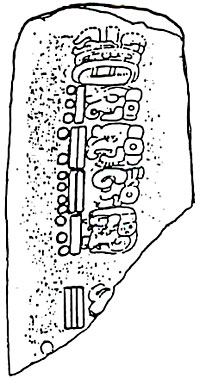 By
the time I was writing The Lost Realms, the book devoted to the
prehistory of the Americas, I was sure that the arrival of the Olmecs with
Thoth/Quetzalcoatl could be established with astounding
precision. The key to unlocking the enigma was the Olmec Calendar. By
the time I was writing The Lost Realms, the book devoted to the
prehistory of the Americas, I was sure that the arrival of the Olmecs with
Thoth/Quetzalcoatl could be established with astounding
precision. The key to unlocking the enigma was the Olmec Calendar.
In addition to the Haab and the Tzolkin, there was in Mesoamerica a
third calendar, used to inscribe dates on monuments. Given the name
the Long Count, it was not cyclical as the other two, but linear --
a continuous one, counting the total number of days that had passed
since the counting began on a mysterious Day One.
By means of glyphs denoting groups of days (1, 20, 360, 7,200 or
even 144,000) and dots and bars giving the number for each
group-glyph, monuments were dated by saying: A total of so many days from Day One have passed when this Monument was erected.
But what was that Day One, when did it occur, and what was its
significance?
It has been established beyond doubt that this Long Count calendar
was the original Olmec calendar; and it is now generally agreed that
Day One was equivalent to August 13, 3113 B.C.
But what does that date signify? As far as I know, the only
plausible answer was provided by me: It was the date of Thoth/Quetzalcoatl's
arrival, with his followers in Mesoamerica!
The Unexpected
Corroboration
All official publications continue, however, to remain at 1250 B.C.
-- 1500 B.C. at most -- as the date of the start of the Olmec
presence.
Imagine my pleasant surprise to come across an eye-witness report by
the astronaut Gordon Cooper in chapter 11 of his book A Leap of
Faith.
"During my final years with NASA," he writes, "I became
involved in a different kind of adventure: undersea treasure hunting
in Mexico."
One day, accompanied by a National Geographic
photographer, they landed in a small plane on an island in the Gulf
of Mexico; local residents pointed out to them pyramid-shaped
mounds, where they found ruins, artifacts and bones. On examination
back in Texas, the artifacts were determined to be 5,000 years old!
"When we learned of the age of the artifacts," Cooper writes, “we
realized that what we'd found had nothing to do with
seventeenth-century Spain... I contacted the Mexican government and
was put in touch with the head of the national archaeology
department, Pablo Bush Romero."
Together with Mexican archeologists the two went back to the site.
After some excavating, Cooper writes,
"The age of the ruins was confirmed:
3000 B.C. Compared with other advanced civilizations, relatively
little was known about this one --called the Olmec."
Proceeding to describe some of the
amazing discoveries about the Olmecs and their achievements,
Gordon
Cooper continues thus:
"Engineers, farmers, artisans, and
traders, the Olmecs had a remarkable civilization. But it is
still not known where they originated... Among the findings that
intrigued me most: celestial navigation symbols and formulas
that, when translated, turned out to be mathematical formulas
used to this day for navigation, and accurate drawings of
constellations, some of which would not be officially
'discovered' until the age of modern telescopes."
It was this, rather than his experiences
as an astronaut, that triggered Gordon Cooper's "Leap of faith":
"This left me wondering: Why have celestial navigation signs if they
weren't navigating celestially?”
And he asks: If ‘someone’ had
helped the Olmecs with this knowledge, from whom did they get it?
My readers, of course, know the answers.
Has the
Cover-up Ended?
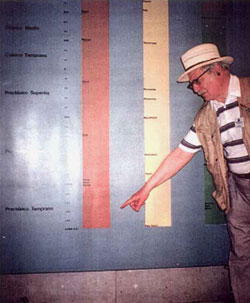
The outstanding museum on the Olmec civilization in Jalapa, in the
Veracruz province of Mexico, included when it was built a wall panel
showing the extent and dates of Mexico's various cultures. On my
first visit there, I could hardly believe my eyes: The first
(earliest) civilization, that of the Olmecs, was shown as begun
circa 3000 B.C.!
I urged the members of my group to take pictures of me pointing to
the date: Finally, the date claimed by me has been officially
accepted!
On a second visit, however (to which the previous article, The Case
of the Missing Elephant relates), not only the telltale elephant-toy
disappeared; the Olmec column starting at 3000 B.C. was also gone...
And the official Museum Catalogue, reviewing the Olmec civilization,
reverted to 1500 B.C.
But now comes the astronaut Gordon Cooper, and innocently and inter-alia
tells, as an eye-witness, what he was told by the chief Mexican
archaeologist: 3000 B.C.
And thus, when all is said and done, I stand vindicated.
Back to Contents
|

 The
Discovery
The
Discovery archaeological
team from Tulane University found another such gigantic stone head
in the adjoining Mexican state of Tabasco; it measured about eight
feet in height and weighed some twenty four tons.
archaeological
team from Tulane University found another such gigantic stone head
in the adjoining Mexican state of Tabasco; it measured about eight
feet in height and weighed some twenty four tons. are
what are considered to be Olmec "toys." They include animals mounted
on wheels -- a visual and evidentiary negation of the common claim
that the people of Mesoamerica (and America in general) were
unfamiliar with the wheel.
are
what are considered to be Olmec "toys." They include animals mounted
on wheels -- a visual and evidentiary negation of the common claim
that the people of Mesoamerica (and America in general) were
unfamiliar with the wheel. Gordon
Cooper, in which his story as a test pilot and astronaut is peppered
with (to quote from the dust jacket),
Gordon
Cooper, in which his story as a test pilot and astronaut is peppered
with (to quote from the dust jacket), 
 By
the time I was writing The Lost Realms, the book devoted to the
prehistory of the Americas, I was sure that the arrival of the Olmecs with
Thoth/Quetzalcoatl could be established with astounding
precision. The key to unlocking the enigma was the Olmec Calendar.
By
the time I was writing The Lost Realms, the book devoted to the
prehistory of the Americas, I was sure that the arrival of the Olmecs with
Thoth/Quetzalcoatl could be established with astounding
precision. The key to unlocking the enigma was the Olmec Calendar.